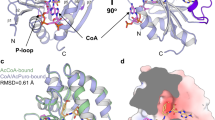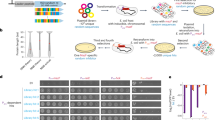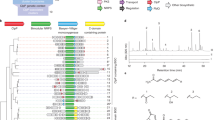Abstract
About one-third of the eukaryotic proteome undergoes ubiquitylation, but the enzymatic cascades leading to substrate modification are largely unknown. We present a genetic selection tool that utilizes Escherichia coli, which lack deubiquitylases, to identify interactions along ubiquitylation cascades. Coexpression of split antibiotic resistance protein tethered to ubiquitin and ubiquitylation target together with a functional ubiquitylation apparatus results in a covalent assembly of the resistance protein, giving rise to bacterial growth on selective media. We applied the selection system to uncover an E3 ligase from the pathogenic bacteria EHEC and to identify the epsin ENTH domain as an ultraweak ubiquitin-binding domain. The latter was complemented with a structure–function analysis of the ENTH–ubiquitin interface. We also constructed and screened a yeast fusion library, discovering Sem1 as a novel ubiquitylation substrate of Rsp5 E3 ligase. Collectively, our selection system provides a robust high-throughput approach for genetic studies of ubiquitylation cascades and for small-molecule modulator screening.
This is a preview of subscription content, access via your institution
Access options
Subscribe to this journal
Receive 12 print issues and online access
$259.00 per year
only $21.58 per issue
Buy this article
- Purchase on Springer Link
- Instant access to full article PDF
Prices may be subject to local taxes which are calculated during checkout






Similar content being viewed by others
References
Weissman, A.M., Shabek, N. & Ciechanover, A. The predator becomes the prey: regulating the ubiquitin system by ubiquitylation and degradation. Nat. Rev. Mol. Cell Biol. 12, 605–620 (2011).
Wild, P. et al. Phosphorylation of the autophagy receptor optineurin restricts Salmonella growth. Science 333, 228–233 (2011).
Nalepa, G., Rolfe, M. & Harper, J.W. Drug discovery in the ubiquitin–proteasome system. Nat. Rev. Drug Discov. 5, 596–613 (2006).
Mizushima, N., Levine, B., Cuervo, A.M. & Klionsky, D.J. Autophagy fights disease through cellular self-digestion. Nature 451, 1069–1075 (2008).
Ciechanover, A. & Brundin, P. The ubiquitin proteasome system in neurodegenerative diseases: sometimes the chicken, sometimes the egg. Neuron 40, 427–446 (2003).
Bachmair, A., Finley, D. & Varshavsky, A. In vivo half-life of a protein is a function of its amino-terminal residue. Science 234, 179–186 (1986).
Deshaies, R.J. & Joazeiro, C.A. RING domain E3 ubiquitin ligases. Annu. Rev. Biochem. 78, 399–434 (2009).
Hershko, A., Ciechanover, A., Heller, H., Haas, A.L. & Rose, I.A. Proposed role of ATP in protein breakdown: conjugation of protein with multiple chains of the polypeptide of ATP-dependent proteolysis. Proc. Natl. Acad. Sci. USA 77, 1783–1786 (1980).
Li, W. et al. Genome-wide and functional annotation of human E3 ubiquitin ligases identifies MULAN, a mitochondrial E3 that regulates the organelle's dynamics and signaling. PLoS One 3, e1487 (2008).
Wilkinson, K.D., Urban, M.K. & Haas, A.L. Ubiquitin is the ATP-dependent proteolysis factor I of rabbit reticulocytes. J. Biol. Chem. 255, 7529–7532 (1980).
Hicke, L., Schubert, H.L. & Hill, C.P. Ubiquitin-binding domains. Nat. Rev. Mol. Cell Biol. 6, 610–621 (2005).
Di Fiore, P.P., Polo, S. & Hofmann, K. When ubiquitin meets ubiquitin receptors: a signaling connection. Nat. Rev. Mol. Cell Biol. 4, 491–497 (2003).
Hoeller, D. et al. Regulation of ubiquitin-binding proteins by monoubiquitination. Nat. Cell Biol. 8, 163–169 (2006).
Hurley, J.H., Lee, S. & Prag, G. Ubiquitin-binding domains. Biochem. J. 399, 361–372 (2006).
Prag, G. et al. Mechanism of ubiquitin recognition by the CUE domain of Vps9p. Cell 113, 609–620 (2003).
Shih, S.C. et al. A ubiquitin-binding motif required for intramolecular monoubiquitylation, the CUE domain. EMBO J. 22, 1273–1281 (2003).
Keren-Kaplan, T. et al. Synthetic biology approach to reconstituting the ubiquitylation cascade in bacteria. EMBO J. 31, 378–390 (2012).
Keren-Kaplan, T. & Prag, G. Purification and crystallization of mono-ubiquitylated ubiquitin receptor Rpn10. Acta Crystallogr. Sect. F Struct. Biol. Cryst. Commun. 68, 1120–1123 (2012).
van den Bogaart, G. et al. Synaptotagmin-1 may be a distance regulator acting upstream of SNARE nucleation. Nat. Struct. Mol. Biol. 18, 805–812 (2011).
Lorick, K.L. et al. RING fingers mediate ubiquitin-conjugating enzyme (E2)-dependent ubiquitination. Proc. Natl. Acad. Sci. USA 96, 11364–11369 (1999).
Shah, M. et al. Inhibition of Siah2 ubiquitin ligase by vitamin K3 (menadione) attenuates hypoxia and MAPK signaling and blocks melanoma tumorigenesis. Pigment Cell Melanoma Res. 22, 799–808 (2009).
Windheim, M., Peggie, M. & Cohen, P. Two different classes of E2 ubiquitin-conjugating enzymes are required for the mono-ubiquitination of proteins and elongation by polyubiquitin chains with a specific topology. Biochem. J. 409, 723–729 (2008).
Wu, B. et al. NleG Type 3 effectors from enterohaemorrhagic Escherichia coli are U-Box E3 ubiquitin ligases. PLoS Pathog. 6, e1000960 (2010).
Tobe, T. et al. An extensive repertoire of type III secretion effectors in Escherichia coli O157 and the role of lambdoid phages in their dissemination. Proc. Natl. Acad. Sci. USA 103, 14941–14946 (2006).
Ren, X. & Hurley, J.H. VHS domains of ESCRT-0 cooperate in high-avidity binding to polyubiquitinated cargo. EMBO J. 29, 1045–1054 (2010).
Polo, S. et al. A single motif responsible for ubiquitin recognition and monoubiquitination in endocytic proteins. Nature 416, 451–455 (2002).
Hirano, S. et al. Double-sided ubiquitin binding of Hrs-UIM in endosomal protein sorting. Nat. Struct. Mol. Biol. 13, 272–277 (2006).
Hoeller, D. et al. E3-independent monoubiquitination of ubiquitin-binding proteins. Mol. Cell 26, 891–898 (2007).
Yang, Y. et al. Inhibitors of ubiquitin-activating enzyme (E1), a new class of potential cancer therapeutics. Cancer Res. 67, 9472–9481 (2007).
Keren-Kaplan, T. et al. Structure-based in silico identification of ubiquitin-binding domains provides insights into the ALIX-V:ubiquitin complex and retrovirus budding. EMBO J. 32, 538–551 (2013).
Misra, S., Beach, B.M. & Hurley, J.H. Structure of the VHS domain of human Tom1 (target of myb 1): insights into interactions with proteins and membranes. Biochemistry 39, 11282–11290 (2000).
Lange, A. et al. Evidence for cooperative and domain-specific binding of the signal transducing adaptor molecule 2 (STAM2) to Lys63-linked diubiquitin. J. Biol. Chem. 287, 18687–18699 (2012).
Ford, M.G. et al. Curvature of clathrin-coated pits driven by epsin. Nature 419, 361–366 (2002).
Misra, S., Puertollano, R., Kato, Y., Bonifacino, J.S. & Hurley, J.H. Structural basis for acidic-cluster-dileucine sorting-signal recognition by VHS domains. Nature 415, 933–937 (2002).
Levin-Reisman, I. et al. Automated imaging with ScanLag reveals previously undetectable bacterial growth phenotypes. Nat. Methods 7, 737–739 (2010).
Schindelin, J. et al. Fiji: an open-source platform for biological-image analysis. Nat. Methods 9, 676–682 (2012).
Vaynberg, J. et al. Structure of an ultraweak protein-protein complex and its crucial role in regulation of cell morphology and motility. Mol. Cell 17, 513–523 (2005).
Malovannaya, A. et al. Analysis of the human endogenous coregulator complexome. Cell 145, 787–799 (2011).
Huang, F. et al. Lysine 63-linked polyubiquitination is required for EGF receptor degradation. Proc. Natl. Acad. Sci. USA 110, 15722–15727 (2013).
Vina-Vilaseca, A. & Sorkin, A. Lysine 63-linked polyubiquitination of the dopamine transporter requires WW3 and WW4 domains of Nedd4-2 and UBE2D ubiquitin-conjugating enzymes. J. Biol. Chem. 285, 7645–7656 (2010).
MacGurn, J.A., Hsu, P.C. & Emr, S.D. Ubiquitin and membrane protein turnover: from cradle to grave. Annu. Rev. Biochem. 81, 231–259 (2012).
Rahighi, S. & Dikic, I. Selectivity of the ubiquitin-binding modules. FEBS Lett. 586, 2705–2710 (2012).
Jäntti, J., Lahdenranta, J., Olkkonen, V.M., Söderlund, H. & Keränen, S. SEM1, a homologue of the split hand/split foot malformation candidate gene Dss1, regulates exocytosis and pseudohyphal differentiation in yeast. Proc. Natl. Acad. Sci. USA 96, 909–914 (1999).
Marston, N.J. et al. Interaction between the product of the breast cancer susceptibility gene BRCA2 and DSS1, a protein functionally conserved from yeast to mammals. Mol. Cell. Biol. 19, 4633–4642 (1999).
Paraskevopoulos, K. et al. Dss1 is a 26S proteasome ubiquitin receptor. Mol. Cell 56, 453–461 (2014).
Chatterjee, C., McGinty, R.K., Fierz, B. & Muir, T.W. Disulfide-directed histone ubiquitylation reveals plasticity in hDot1L activation. Nat. Chem. Biol. 6, 267–269 (2010).
Chen, J., Ai, Y., Wang, J., Haracska, L. & Zhuang, Z. Chemically ubiquitylated PCNA as a probe for eukaryotic translesion DNA synthesis. Nat. Chem. Biol. 6, 270–272 (2010).
Kumar, K.S., Spasser, L., Erlich, L.A., Bavikar, S.N. & Brik, A. Total chemical synthesis of di-ubiquitin chains. Angew. Chem. Int. Edn. Engl. 49, 9126–9131 (2010).
Kamadurai, H.B. et al. Mechanism of ubiquitin ligation and lysine prioritization by a HECT E3. eLife 2, e00828 (2013).
Du, Y., Xu, N., Lu, M. & Li, T. hUbiquitome: a database of experimentally verified ubiquitination cascades in humans. Database (Oxford) 2011, bar055 (2011).
Gibson, D.G. et al. Enzymatic assembly of DNA molecules up to several hundred kilobases. Nat. Methods 6, 343–345 (2009).
Sheffield, P., Garrard, S. & Derewenda, Z. Overcoming expression and purification problems of RhoGDI using a family of “parallel” expression vectors. Protein Expr. Purif. 15, 34–39 (1999).
Tanner, N. & Prag, G. Purification and crystallization of yeast Ent1 ENTH domain. Acta Crystallogr. Sect. F Struct. Biol. Cryst. Commun. 68, 820–823 (2012).
Otwinowski, Z. & Minor, W. Processing of X-ray diffraction data collected in oscillation mode. Methods Enzymol. 276, 307–326 (1997).
McCoy, A.J. Solving structures of protein complexes by molecular replacement with Phaser. Acta Crystallogr. D Biol. Crystallogr. 63, 32–41 (2007).
Adams, P.D. et al. PHENIX: building new software for automated crystallographic structure determination. Acta Crystallogr. D Biol. Crystallogr. 58, 1948–1954 (2002).
Murshudov, G.N., Vagin, A.A. & Dodson, E.J. Refinement of macromolecular structures by the maximum-likelihood method. Acta Crystallogr. D Biol. Crystallogr. 53, 240–255 (1997).
Emsley, P. & Cowtan, K. Coot: model-building tools for molecular graphics. Acta Crystallogr. D Biol. Crystallogr. 60, 2126–2132 (2004).
Azem, A., Weiss, C. & Goloubinoff, P. Structural analysis of GroE chaperonin complexes using chemical cross-linking. Methods Enzymol. 290, 253–268 (1998).
Acknowledgements
This manuscript is dedicated to the memory of Amos Oppenheim (1934–2006), my Ph.D. mentor and friend who was influential in determining this choice of research. We thank the teams of ID29 and ID14-4 beamlines at ESRF for their exceptional help and for maintaining and upgrading the facility. We thank S.D. Emr and H.C. Ho (Cornell University, Ithaca), A. Chitnis and S.Y. Choi (NIH, Maryland) for providing the rsp5-1 strain and Epn1 cDNA, respectively, and for fruitful discussions. We thank N. Balaban (The Hebrew University, Jerusalem), Z. Ronai (SBP at La Jolla, California), J. Bonifacino (NIH, Maryland) and J. Hurley (UC Berkeley) for providing the pZE21 vector, SIAH2, GGA1/2 and STAM1-VHS clones, respectively. We thank I. Rosenshine (The Hebrew University, Jerusalem) for providing EHEC gDNA and for influential discussions. This work was supported by grants from the Israeli Science Foundation (no. 464/2011) and the Israeli Ministry of Health (no. 3000005108) to G.P.
Author information
Authors and Affiliations
Contributions
O.L.-K. constructed and evaluated the selection system, constructed the yeast E2 library, determined the structure of zebrafish ENTH, performed genetic analysis of ENTH–Ub interactions and wrote the manuscript; N.T. crystalized and determined the structure of yeast ENTH domain and performed yeast ENTH–Ub binding assays; N.S. identified and characterized NleG6-3 and inhibition assays; S.A. performed inhibition assay with SIAH2; A.V. performed SPR measurements; Y.R. performed ubiquitylation assays with zebrafish Epn1; X.S. performed the genetic analysis of GGA and STAM; I.A. assisted the SPR and growth-data analyses; T.K.-K., A.S., O.Z. and T.B. performed some selection experiments and analysis; C.K. cloned the HRS/STAM to the genetic system; I.P. provided technical help; S.B.-A. helped with library construction; G.P. conceived the idea, designed the experiments, supported structures determination and data analyses and wrote the manuscript.
Corresponding author
Ethics declarations
Competing interests
The technology transfer company of Tel Aviv University (RAMOT) has filed a provisional based on our developed system. The provisional number is 62/371,881.
Integrated supplementary information
Supplementary Figure 1 Schemes show two major hurdles in the ubiquitin field.
The two pose challenges in assigning specific associations of components along ubiquitin cascades. (a) Ubiquitylation is rapidly reversed by deubiquitylases. In human there are about hundred deubiquitylating enzymes (DUBs) which efficiently and rapidly remove the ubiquitin moiety from targeted proteins. (b) Ubiquitylation cascades are multiplex. For example eight different substrates were found for the BRCA1 E3-ligase. Similarly, 7 different E3-ligases were demonstrated to ubiquitylate p53.
Supplementary Figure 2 Architecture and sequence of the linkers connecting the DHFR fragments to ubiquitin and to ubiquitylation target
Schematic illustration of the constructs used in the selection system. pND-Ub vectors contain a N-Terminal DHFR fragment fused through the flexible linker (linker 1) to Ub. In the pCD-Sub the C-Terminal fragment of the DHFR was fused through the flexible linker (linker 2) to the His6-MBP-substrate or directly to the substrate.
Supplementary Figure 3 Domain architecture of membrane associated Ub-receptors.
Ub moieties mark the binding sites (orange circled U’s).
Supplementary Figure 4 Ent1-ENTH domain directly binds ubiquitin.
(a) Shows crosslinking assay of Ent1-ENTH domain with increased concentrations of Ub. A mild crosslinker, disuccinimidyl suberate (DSS) was used. Reactions were resolved by SDS-PAGE and Coomassie blue stained. (b) Shows crosslinking assay (like in a) of Ent1-ENTH domain with wild-type and Ub I44E mutant for various incubation times (as indicated). (c) Scheme of yeast and zebrafish Epsin-1 derivative constructs show blow in (d) and (e). (d,e) Ubiquitylation of yeast and zebrafish Epsin-1 derivatives. His6-Ub was co-expressed with E1 and Ubc4 along with GST-Epsin1 derivatives. Proteins were purified on GSH-beads and ubiquitylation was detected by western blot using anti-Histag antibody as described in17.
Supplementary Figure 5 Structural divergence within the ENTH domains.
a. The coordinates of several ENTH domains including yeast (magenta), zebrafish (white), and three structures of rat ENTH domains (cyan, red and yellow), were superposed. The axis of helix-8 from each of the structures were calculated. Then the angles among the derived helices were compared. b. Structural differences between the loops tethering helices number 3 and 4 in yeast and zebrafish ENTH domains are presented.
Supplementary Figure 6 ENTH/VHS domains can simultaneously associate with membranes, M6PR-tail and ubiquitin.
Superimposing the ENTH complex with the lipid phosphatidylinositol-4,5-bisphosphate, GGA3-VHS complex with the Mannose-6P Receptor tail and the STAM1-VHS:Ub shows that membrane and Ub associations occur at opposite sides of the domain and therefore can occur simultaneously.
Supplementary Figure 7 Surface Plasmon Response (SPR) analysis of ENTH:Ub interaction.
Crude response curves for the wild-type and indicated mutants are shown for each of the measured analyte concentrations
Supplementary information
Supplementary Text and Figures
Supplementary Figures 1–7 and Supplementary Tables 1 and 2. (PDF 1385 kb)
Supplementary Table 3
Supplementary Table 3 (XLSX 11 kb)
Bacterial growth time-lapse shows Rsp5-dependent Sem1 ubiquitylation
Time-lapse scans showing ubiquitylation dependent bacterial growth assay. Selective (left) and non-selective (right) plates were spotted with the indicated bacteria: DHFR (positive control); complete system contains E1-E2-E3 and Sem1; ΔRsp5; ΔRsp5,ΔUbc4; ΔUb. Scans were taken every 30 minutes for 100 hours (time shown at top left). (GIF 61150 kb)
Rights and permissions
About this article
Cite this article
Levin-Kravets, O., Tanner, N., Shohat, N. et al. A bacterial genetic selection system for ubiquitylation cascade discovery. Nat Methods 13, 945–952 (2016). https://doi.org/10.1038/nmeth.4003
Received:
Accepted:
Published:
Issue Date:
DOI: https://doi.org/10.1038/nmeth.4003
This article is cited by
-
Structure of ubiquitylated-Rpn10 provides insight into its autoregulation mechanism
Nature Communications (2016)



